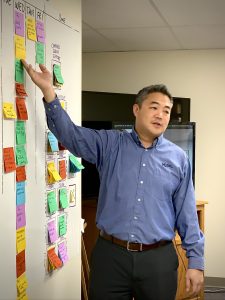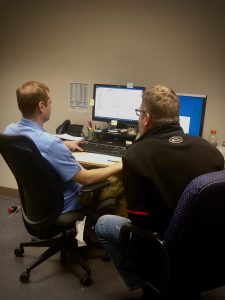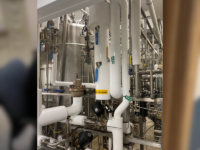
Preparing for intellectual knowledge loss
after your employees retire is not a good plan. According to a December 2019 government census report, by 2030 all baby boomers will be 65 or older. Currently, that is an estimated 73 million people who will no longer be part of the work force. The census report estimates about 10,000 people per day “cross the threshold”
* to retirement. Brain drain, aging control systems for which parts are becoming increasingly rare, and the loss of paper knowledge with misplaced drawings and operators’ manuals, combine to put companies in an increasingly difficult situation. Without a good succession plan, “tacit or tribal knowledge” often goes out the door and vaporizes. Every company will face the knowledge drain to some degree due to the sheer number of workers in the baby boomer group. The time to plan is today.
MAKE A PLAN
Creating a plan now can greatly increase business success. Technical training is just the beginning to covering the knowledge loss when an employee leaves. Organizational or Tribal knowledge, how the job is done, practices and process, organizational culture, knowledge of legacy systems, and key people to work with are all part of the knowledge drain. This is where, according to Keith Mandachit, Engineering Manager at Huffman Engineering, Inc, a good system integrator can be beneficial.
“System integrators have personnel that have a wide range of knowledge because we work on various systems and different technologies,” he says. ”We learn and become experts on tools from multiple manufacturers. We also apply our knowledge on different applications like vision or sensors or instrumentation.”
“I’ve been involved with many control system upgrades over the past 30 plus years, and it is amazing how frequently the control system documentation is either nonexistent or out of date.” Said Dave Penner, P.E. who works for design firm HDR. “Facility management typically relies on at least one staff person to have complete understanding of their control system – all in their head! I’ve seen what happens when that person retires or moves on. The plant staff is left struggling to efficiently operate their own facility. It is extremely important for a facility to have complete up to date control system documentation to enable plant staff to know how to operate efficiently, and to maintain, trouble shoot and repair the control system.”
DOCUMENT THE PROCESS

Mandachit has a list of ways clients can use a systems integration firm to prepare for the drain on intellectual property. The first thing is to document the process. “At Huffman Engineering, our engineers know the starting place is good documentation. If there isn’t a good set of drawings or the process isn’t documented, the best thing to do is to carve out the time to allow someone to get that information out of an operator’s head and down on paper.”
“In my experience, no one provides better documentation than Huffman Engineering,” Penner said. “I’ve provided control system design upgrades for numerous facilities where Huffman Engineering has provided comprehensive documentation. Huffman’s documentation typically includes everything from high level network communication diagrams, annotated PLC logic, equipment manuals, and detailed wiring diagrams. Not only were the documents a real asset to the Facility Owners, but the documents really helped me as the design engineer to be efficient in design and to provide accurate upgrade design documents to the Contractor.”
The minimum documents Mandachit suggests are drawings and a control narrative or loop descriptions. “These basic documents carry a lot of information,” he said. “Drawings are a roadmap. Without them, the system often does not make sense.” Troubleshooting, ordering replacement parts, and tracing how things work together can all be gleaned from a good set of drawings according to Mandachit.
Control narratives complete the picture for the system. They describe how the system is supposed to work. Mandachit said all Huffman Engineering projects begin with either a full narrative or part of one. Even without an upgrade, taking the time to carve out a budget to create control narratives for existing systems will go a long way in ensuring ongoing performance of current systems.
CAPTURE EXISTING KNOWLEDGE
“If the person who knows everything is still around, it makes a system easier to document,” Mandachit contends. “Without them it is not impossible, but it’s a lot harder when there is not a starting place. We put a high emphasis on documenting the process each time we do a project. The person at a plant may understand their system and the intricacies of how it works. It is all in the individual’s head. We put that information on paper.”
“The City of Omaha made the decision several years ago to establish standards and protocols for all projects in a multi-decade program to address combined sewer overflows. This was a practical decision due to the magnitude of the program and the number of projects which would need to work together to meet the long term goals. Huffman Engineering worked with the City to develop these SCADA standards documents and protocols. Before these protocols were established, documentation was limited and relied heavily on tacit knowledge of individuals directly involved in the work. The real long term benefits of establishing SCADA standards documents and protocols go beyond consistency project to project. These standards capture and document the decision making and programming process for the project, program, and for the next generation of engineers, technologists, and operators to come.” – Mike Arends, Plant Manager, Missouri River Wastewater Treatment Plant
The danger, Mandachit said, is when plant personnel retire the information walks out the door. By capturing the process, he said, the efficiency realized might not be measurable, but it is visible. Documentation is saved from one project to the next at Huffman Engineering, Inc., allowing a different team to pick up a similar project at a plant and save many hours in mobilization. Mandachit estimated good documentation could almost cut the effort in half. If Huffman Engineering can save time doing similar projects across clients, a single client can save even more time with good documents. Plant personnel are pulled in many directions. Documentation allows knowledge to live on paper instead of in an individual’s head.
TIME TO UPGRADE
One of the best things a company can do according to Mandachit, is to upgrade existing systems to more user-friendly systems. “Now would be a good time to automate something that has not been if you have personnel who understand the process and system. They would know more than anyone else the approach to use to make it run smoothly.”
Cost savings on automation equipment make this a good time to replace legacy systems. “The longer you go with an older system, the harder it will be to upgrade,” Mandachit said. “Many manufacturers have an upgrade path. No manufacturer will support, or be able to support, all their equipment and software forever. The longer you wait, the harder it will become to upgrade efficiently and cost effectively.”
TRUSTING OUTSIDE EXPERTISE
At Huffman Engineering, Inc. the process of succession has begun. “One example of what we are doing is pairing up engineers. One may be looking toward retirement and we pair him with a younger engineer so when they go out on a call the transfer of knowledge happens in a practical way,” Mandachit explained. “A benefit from being a system integrator is that working on a variety of projects we gain the experience and know-how of getting into someone else’s system and understanding how it works and translating that onto paper.”
Younger engineers are required to write a lot of the control narratives and loop descriptions. They are involved in design reviews and code reviews. Training occurs all the time at Huffman Engineering. They quickly learn to ask pertinent questions and understand systems. The PLC program is just one of the many puzzle pieces to a system.

“Being able to take an existing program and figure out what’s going on is an ability that we have,” Mandachit explained. “It is not an easy thing to take someone else’s program and figure out what they did, but we can focus on the task at hand because we are used to doing projects rather than focusing on the day-to-day tasks of running a company or keeping a system operating.”
“There are a lot of pieces to the control puzzle, and they are getting more complex all the time,” Mandachit concluded. “Because things are more complex, systems and processes have to be documented better. We have gone from a 500-piece puzzle to a ten-thousand-piece puzzle. The trend of increasing complexity will continue to grow. Documenting processes only makes sense to protect valuable intellectual property.”
PREPARE NOW FOR KNOWLEDGE DRAIN:
- Transfer knowledge to paper
- Make sure you have accurate drawings
- Make sure you have accurate control narratives or loop diagrams
- Make sure you can locate your manuals and they are up to date
- Take time to train younger employees in legacy system up keep
- Automate manual systems or upgrade older systems
- Trust experts to understand your systems even after your key technical people have gone
* Reference:
https://www.census.gov/library/stories/2019/12/by-2030-all-baby-boomers-will-be-age-65-or-older.html
 Preparing for intellectual knowledge loss after your employees retire is not a good plan. According to a December 2019 government census report, by 2030 all baby boomers will be 65 or older. Currently, that is an estimated 73 million people who will no longer be part of the work force. The census report estimates about 10,000 people per day “cross the threshold”* to retirement. Brain drain, aging control systems for which parts are becoming increasingly rare, and the loss of paper knowledge with misplaced drawings and operators’ manuals, combine to put companies in an increasingly difficult situation. Without a good succession plan, “tacit or tribal knowledge” often goes out the door and vaporizes. Every company will face the knowledge drain to some degree due to the sheer number of workers in the baby boomer group. The time to plan is today.
Preparing for intellectual knowledge loss after your employees retire is not a good plan. According to a December 2019 government census report, by 2030 all baby boomers will be 65 or older. Currently, that is an estimated 73 million people who will no longer be part of the work force. The census report estimates about 10,000 people per day “cross the threshold”* to retirement. Brain drain, aging control systems for which parts are becoming increasingly rare, and the loss of paper knowledge with misplaced drawings and operators’ manuals, combine to put companies in an increasingly difficult situation. Without a good succession plan, “tacit or tribal knowledge” often goes out the door and vaporizes. Every company will face the knowledge drain to some degree due to the sheer number of workers in the baby boomer group. The time to plan is today.
 Mandachit has a list of ways clients can use a systems integration firm to prepare for the drain on intellectual property. The first thing is to document the process. “At Huffman Engineering, our engineers know the starting place is good documentation. If there isn’t a good set of drawings or the process isn’t documented, the best thing to do is to carve out the time to allow someone to get that information out of an operator’s head and down on paper.”
“In my experience, no one provides better documentation than Huffman Engineering,” Penner said. “I’ve provided control system design upgrades for numerous facilities where Huffman Engineering has provided comprehensive documentation. Huffman’s documentation typically includes everything from high level network communication diagrams, annotated PLC logic, equipment manuals, and detailed wiring diagrams. Not only were the documents a real asset to the Facility Owners, but the documents really helped me as the design engineer to be efficient in design and to provide accurate upgrade design documents to the Contractor.”
The minimum documents Mandachit suggests are drawings and a control narrative or loop descriptions. “These basic documents carry a lot of information,” he said. “Drawings are a roadmap. Without them, the system often does not make sense.” Troubleshooting, ordering replacement parts, and tracing how things work together can all be gleaned from a good set of drawings according to Mandachit.
Control narratives complete the picture for the system. They describe how the system is supposed to work. Mandachit said all Huffman Engineering projects begin with either a full narrative or part of one. Even without an upgrade, taking the time to carve out a budget to create control narratives for existing systems will go a long way in ensuring ongoing performance of current systems.
Mandachit has a list of ways clients can use a systems integration firm to prepare for the drain on intellectual property. The first thing is to document the process. “At Huffman Engineering, our engineers know the starting place is good documentation. If there isn’t a good set of drawings or the process isn’t documented, the best thing to do is to carve out the time to allow someone to get that information out of an operator’s head and down on paper.”
“In my experience, no one provides better documentation than Huffman Engineering,” Penner said. “I’ve provided control system design upgrades for numerous facilities where Huffman Engineering has provided comprehensive documentation. Huffman’s documentation typically includes everything from high level network communication diagrams, annotated PLC logic, equipment manuals, and detailed wiring diagrams. Not only were the documents a real asset to the Facility Owners, but the documents really helped me as the design engineer to be efficient in design and to provide accurate upgrade design documents to the Contractor.”
The minimum documents Mandachit suggests are drawings and a control narrative or loop descriptions. “These basic documents carry a lot of information,” he said. “Drawings are a roadmap. Without them, the system often does not make sense.” Troubleshooting, ordering replacement parts, and tracing how things work together can all be gleaned from a good set of drawings according to Mandachit.
Control narratives complete the picture for the system. They describe how the system is supposed to work. Mandachit said all Huffman Engineering projects begin with either a full narrative or part of one. Even without an upgrade, taking the time to carve out a budget to create control narratives for existing systems will go a long way in ensuring ongoing performance of current systems.
 “Being able to take an existing program and figure out what’s going on is an ability that we have,” Mandachit explained. “It is not an easy thing to take someone else’s program and figure out what they did, but we can focus on the task at hand because we are used to doing projects rather than focusing on the day-to-day tasks of running a company or keeping a system operating.”
“There are a lot of pieces to the control puzzle, and they are getting more complex all the time,” Mandachit concluded. “Because things are more complex, systems and processes have to be documented better. We have gone from a 500-piece puzzle to a ten-thousand-piece puzzle. The trend of increasing complexity will continue to grow. Documenting processes only makes sense to protect valuable intellectual property.”
“Being able to take an existing program and figure out what’s going on is an ability that we have,” Mandachit explained. “It is not an easy thing to take someone else’s program and figure out what they did, but we can focus on the task at hand because we are used to doing projects rather than focusing on the day-to-day tasks of running a company or keeping a system operating.”
“There are a lot of pieces to the control puzzle, and they are getting more complex all the time,” Mandachit concluded. “Because things are more complex, systems and processes have to be documented better. We have gone from a 500-piece puzzle to a ten-thousand-piece puzzle. The trend of increasing complexity will continue to grow. Documenting processes only makes sense to protect valuable intellectual property.”




